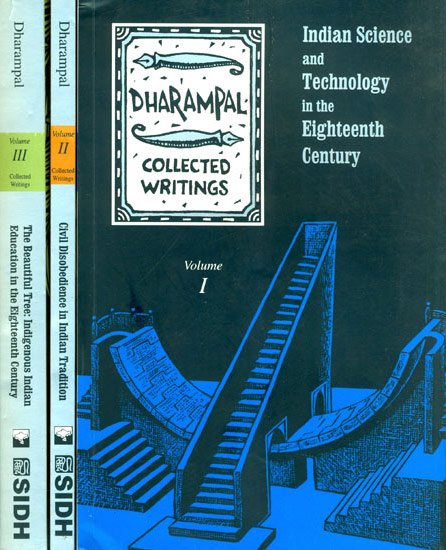Dharampal Collected Writings
author: Dharampal
edition: 2016, Other India BookStore
pages: 1835
ISBN-10: 8185569509
ISBN-13: 9788185569505
Topic: History
Volume 3: About the Book
In 1931, Mahatma Gandhi generated a controversy among the British by observing that literacy in India had actually declined during the preceding century and that the colonial rulers were squarely responsible for this state of affairs.
'Instead of taking a hold of things as they were, 'he said,
'they began to root them out. They scratched the soil and began to look at the root and left the root like that, and the beautiful tree perished.'
England's intellectual elite protested Gandhiji's observations. But Dharampal's research into Indian and British archives proves beyond doubt that not only did India have a functioning indigenous educational system at the end of the eighteenth century but that it actually compared more than favourably with the system obtaining in England at the time in respect of the number of schools and colleges proportionate to the population, the number of students in school and college, the diligence as well as the intelligence of the students, the quality of teachers and the financial support provided from public and private source . Contrary to received opinion, those attending school and college included an impressive percentage of lower caste students, Muslims and girls.
The Beautiful Tree: Indigenous Indian Education in the Eighteenth Century is the third in the series of five volumes of the Collected Writings of Dharampal brought out in special edition by Other India Press and SIDH.
Preface A great deal of scholarly work has been published on the history of education in India, especially during the 1930s, and 1940s. In fact, writings on the subject, initially by British officials-cum- scholars started to appear as early as the mid-nineteenth century. Most of these histories, however, relate to the ancient period, sometimes going as far back as the tenth or twelfth century A.D. Others deal with the history of education during British rule and thereafter. Besides detailed scholarly works on specific ancient educational institutions (such as those at Nalanda or Taxila), there are more general works like that of A.S. Altekar on the ancient period. For the later period, there have been several publications: besides the two volumes of Selections from Educational Records, published and recently reprinted by the Government of India itself,2 the work of S. Nurullah and J.P. Naik may be mentioned here.3 The latter work is interestingly described by the two authors (thus indicating its time and mood) as an attempt at a 'well-documented and comprehensive account of Indian educational history during the last one hundred and sixty years and to interpret it from the Indian point of view.4 Reaching a far wider audience is the voluminous, though perhaps less academic, work of Pandit Sundarlal, first published in 1939.5 The 36th chapter of this celebrated work entitled, 'The Destruction of Indian Indigenous Education', runs into 40 pages, and quotes extensively from various British authorities. These span almost a century: from the Dispatch from England of 3rd June 1814 to the Governor General in India, to the observations of Max Mueller; and the 1910 remarks of the British labour leader, Keir Hardie. However, given the period in which the book was written and the inaccessibility of the detailed manuscript records, it was inevitable that the author had to base his work entirely on existing printed sources. Nevertheless, as an introduction this chapter of Bharat mein Angreji Raj is a landmark on the subject of indigenous Indian education in the late 18th and early 19th centuries. Very little, however has been written on the history or state of education during this period starting with the thirteenth century and up until the early nineteenth century. Undoubtedly there are a few works like that of S.M. Jaffar6 pertaining to Muslim education here are a chapter or two, or some cursory references in most educational histories pertaining to the period of British rule and to the decayed state of indigenous Indian education in the late eighteenth and early nineteenth centuries. Nurullah's and Naik's book7 devotes the first 43 pages (out of 643 pages) to discussing the state of indigenous education in the early nineteenth century. and in challenging certain later British views about the nature and extent of it.
